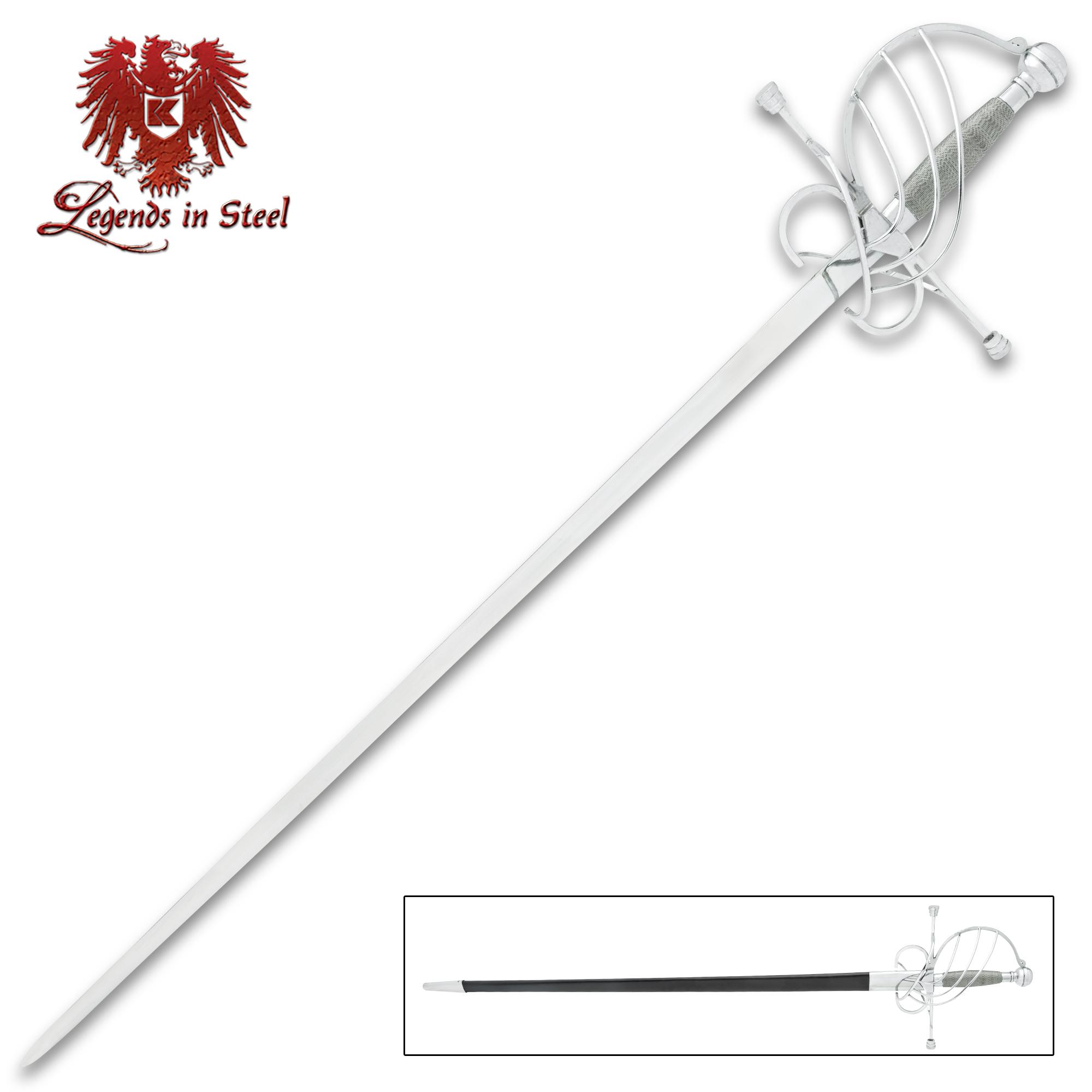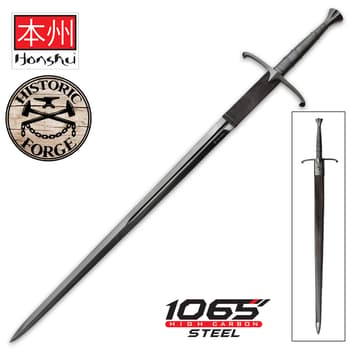Sword Types Throughout History

By Desiree Weeks
Swords have been a tried-and-true weapon of choice for centuries. Their origin can be traced back to the Bronze Age of 3300 BC. They evolved from knives and daggers when construction of longer blades became possible thanks to new materials like arsenic copper and tin-bronze. Since that time, swords have evolved with different kinds meeting the needs of the specific era and culture in which they were made.
Here are just a few of the types of swords that have come to be and some of the modern pieces that pay homage on BudK!
Katana
Beloved by collectors and warriors alike, the Japanese Katana continues to be a fan favorite sword. The katana is known for its curved, single-edged blade and circular or squared tsuba, often ornate in nature. The handle is long enough to be wielded with two hands and is often wrapped in ray skin with a braided cord on top. A katana blade is usually around 27 1/2" long, making it shorter than the blade on a tachi, which was the katana’s predecessor. Katanas can be stored in their traditional wooden lacquered scabbards and require regular maintenance to stay in peak condition.
 |
 |
 |
 |
Shinwa Black Knight Handmade Katana
A true representation of the katana’s beauty is the Shinwa Black Knight Handmade Katana. It has all the features you’d expect from an authentic piece, including a cast tsuba with ornate dragon design, sharp black Damascus steel blade, and a handle wrapped in faux ray skin and classic black ito.
Honshu Boshin Katana
A more modern take on the katana can be found in the Honshu Boshin Katana . It features a 1060 high carbon steel blade, rugged TPR handle, and a tough wooden scabbard with traditional black leather hanging cord.
Long Sword
One sword type popularized during the late medieval and Renaissance periods is the longsword. As the name would imply, the longsword has a cross shaped grip for two-handed use, usually measuring 6 to 12 inches, and a straight double-edged blade usually 31 to 43 inches long. While longswords are known for having two-handed hilts, they can have a variety of different blade cross-sections including diamond, hollow ground, hexagonal, thickened diamond, lenticular, fuller, double fuller, and broad fuller.
 |
 |
 |
 |
Legends in Steel Knights Templar Long Sword
Own a piece of history with the Legends in Steel Knights Templar Long Sword. This piece is inspired by the classic medieval-style sword and features an etched stainless steel blade and ornate, gold colored cast metal guard, handle, and pommel. It makes for a great display piece with its include wall plaque.
Norseman Viking Long Sword
A classic historical representation piece is the Norseman Viking Long Sword. This high-quality historical reproduction features a leather wrapped handle, genuine leather scabbard, and high carbon steel blade with heavy blood groove.
Saber
A saber is a sword with a curved, single-edge blade and a knuckle guard and was traditionally carried either on the shoulder or waist. The lighter sabers became popular with early 17th century infantry while models with less curved blades were used by the heavy cavalry during the 19th century. While they certainly saw plenty of use in battle over the centuries, it was replaced by armored cavalry during WWI.
 |
 |
 |
 |
USMC Ceremonial Saber
This officially licensed USMC Ceremonial Saber Sword is perfect for any collector. It has a stainless steel USMC embossed blade, black faux leather sheath with stainless steel accents, and stainless steel hilt with metalwork details.
Combat Commander Saber
The Combat Commander Saber Sword is a modern, combat-ready take on a saber. It has a 1065 high carbon steel blade with black hard coating and a fiber filled ABS handle. Easily house this 36” saber in its nylon sheath with PVC liner.
Rapier
A rapier is a sword that appears delicate yet proves that looks can be deceiving. It is known for its slender two-edged blade with sharp point. The hilt is typically ornate and meant to protect the entire hand. It originated in Spain as a “dress sword” and would go on to be considered a choice weapon of the wealthy. It was used for dueling and self-defense and is still carried to this day by the Swiss Guard at the Vatican.
 |
 |
 |
 |
Legends In Steel Combat Rapier
The ornate basket-style handguard of the Legends in Steel Combat Rapier is sure to draw attention. It encases the sword’s wire-wrapped handle with sphere-shaped pommel. It has a display edge blade with mirror polish finish, perfect for display or costume.
Classic Medieval Rapier Dagger
A shorter take on the rapier is the Classic Medieval Rapier Dagger. While it may have a shorter blade, it still had the eye-catching basket hilt of a rapier and a bone handle.
Cutlass
While some may know it as simply a pirate sword, the cutlass is more than that. A cutlass is a short, broad sword that can have either a straight or slightly curved blade. The hilt typically has a solid cupped or basket hilt. While it did see some use on land, the cutlass is best known as a sailor’s weapon. It was popular as a naval sidearm as it was able to cut through heavy ropes, canvas, and wood while being short enough to use in close quarters combat. It’s clear why pirates showed favor to this versatile sword type. The cutlass remained an official weapon of the US Navy until 1949 and still sees use as a ceremonial piece.
 |
 |
 |
 |
Pirate Cutlass Sword
Ready for a pirate’s life? Check out the Pirate Cutlass Sword. The basket hilt guard has an ornate piece of artwork depicting a pirate ship and skulls, sabers, and flintlock pistols adorn the custom blade sheath. Truly a perfect display piece for the pirate enthusiast.
US Navy Cutlass
If you’re looking for a more classic cutlass, the 1860 US Navy Cutlass may fit the bill. It has a sleek yet still historic look and is a faithful US Navy replica. It features an enlarged brass basket handguard, leather wrapped cast metal sheath, and carbon steel blade.



